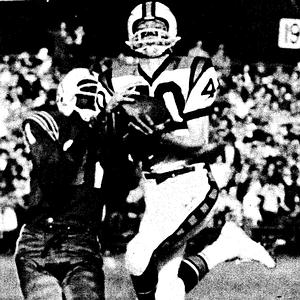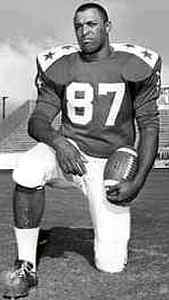Practice for almost every school differed from today's
procedures. There were no wet-bulb thermometers, no concern with
heat index readings, and no medical personnel at practice. No matter
what the temperature and humidity were, the team practiced in full
pads and as I had experienced in high school, with no water breaks.
This was not barbaric, it was standard procedure. At UC, we were
told that an experiment of sorts would take place and that in
addition to the handful of salt tablets that would be gulped down
prior to practice, another standard procedure at every school dating
to the 1940's, we would be allowed the very advanced practice
allowance of one water-break at each session. A whistle would blow
at the approximate half-way mark of practice, two lines would form,
and a trainer would walk down each line with a single metal bucket
of iced water. We were admonished to keep our muddy, dirty hands out
of the water. A dipper or ladle would be offered with the bucket and
as the student trainer stood in front of each man, he would scoop a
dipper of water and ice cubes from the bucket and shovel the entire
thing into his mouth. Of course, many of the fellows also reached in
for a handful of cooling ice which meant that everyone after perhaps
the third man in line, got a mouthful of the grass, mud, and the
saliva and mucous of every previous player in line! The fellows at
the end of the line, and one never knew which end the trainers would
start from, were left with a disgusting mass of phlegm, mud, and an
occasional band-aid. Needless to say, these rather unsanitary
practices would horrify the modern player but we were grateful for
the three or five minute break from the brutally hot and brutally
physical practices and for the water. In conjunction with the
standard rule in almost every college and high school that your
helmet was not to be removed once you stepped onto the practice
field, the unhygienic water break was seen as a blessing and in
retrospect, may have prevented a number of cases of heat-related
illness.
We had practiced for weeks and on the trimester system at UC, the
football season would begin before school and classes actually
began, thus, it was an extremely long and fatiguing camp. At a
Thursday post-practice meeting, the freshman team received great
news; we would report for the usual morning practice and pound each
other into jelly, but instead of returning to the dorms, a meeting,
an afternoon practice, and an evening meeting, we would be allowed
to go home and would not have to return until mandatory check-in at
9 PM on Sunday evening. This announcement was met with glee and
shouts of excitement but being the only one from New York, the only
one who in fact was not from Ohio, Western Pennsylvania, Kentucky,
or Indiana, all within easy driving distance from the campus, I was
to be left on my own. The coaches told me later that arrangements
would be made so that I had access to my room and money for food
off-campus unless I could go home with one of the fellows who was
heading for home. Aware of my plight, I was fortunate enough to
receive a number of invitations and agreed to hitchhike to the
Blacklick, Ohio home of center/linebacker Steve Geiger who had been
an All State performer at Gahanna Lincoln High School. He told me
that once we thumbed a ride to the Columbus area, his wife would
pick us up and we could watch his former high school play Groveport
and while none of this meant much to me other than a chance to
finally see an Ohio high school football game and get away from
practice for a few days, I was about to embark into an entirely new
world where the attitude and level of high school football was truly
amazing.



